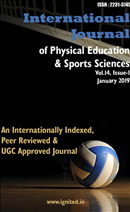A Quantitative Analysis of Squash Shot Accuracy
Main Article Content
Authors
Abstract
The purpose of this analysis was to determine the validity of the Hunt Squash Accuracy Test to predict the success of certain game types. The exact matching of such shot during tournament match-play was contrasted with the precision of the corresponding shot form in the HSAT. The average HSAT value association was substantially high (0.95), the total precision of the shot (0.90), the average consistency of the backhand percentage (0.94) and the total association of the forehand percentage (0.77). The only unique HSAT shooting forms with a substantially high connexon were: straight drive BH (0.92) and straight volleyball BH (0.97). The majority of the styles of shot; boasts, rises and declines both displayed major similarities both on the BH and on the FH line.
Downloads
Article Details
Section
References
- Lees, A. (2003). Science and the major racket sports: a review. Journal of sports sciences, 21(9), pp. 707- 732.
- Vučković, G., Perš, J., James, N., & Hughes, M. (2009). Tactical use of the T area in squash by players of differing standard. Journal of sports sciences, 27(8), pp. 863-871.
- Pereira, A., Wells, J., & Hughes, M. (2001). Notational analysis of elite women’s movement patterns in squash. In M. Hughes & I. M. Franks (Eds.), pass.com (pp. 223-237). Cardiff: CPA, University of Wales Institue, Cardiff
- Müller, E., Benko, U., Raschner, C., & Schwameder, H. (2000). Specific fitness training and testing in competitive sports. Medicine and science in sports and exercise, 32(1), pp. 216-220.
- Wilkinson, M., Leedale-Brown, D., & Winter, E. M. (2009a). Reproducibility of physiological and performance measures from a squash-specific fitness test. International Journal of Sports Physiology & Performance, 4(1).
- Williams, B. K., Hunt, G. B., Graham-Smith, P., & Bourdon, P. C. (2014, July 12 – 16). Measuring squash hitting accuracy using the 'Hunt Squash Accuracy Test'. Paper presented at the 32nd Conference of the International Society of Biomechanics in Sports, Johnson City, TN, United States of America.
- Wilkinson, M., Leedale-Brown, D., & Winter, E. M. (2009b). Validity of a squash-specific test of change-of-direction speed. International Journal of Sports Physiology & Performance, 4(2)
- Elliott, B., Marshall, R., & Noffal, G. (1996). The role of upper limb segment rotations in the development of racket‐head speed in the squash forehand. Journal of sports sciences, 14(2), pp. 159- 165.
- Cohen, J. (2008). Statistical Power Analysis for the Behavioral Sciences (2nd ed.). Hillsdale, NJ: L. Erlbaum Associates.
- Hughes, M., & Franks, I. M. (2008). Dynamic patterns of movement of squash players of different standards in winning and losing rallies. Ergonomics, 37(1), pp. 23-29.
- Vučković, G., James, N., Hughes, M., Murray, S., Sporiš, G., & Perš, J. (2013). The effect of court location and available time on the tactical shot selection of elite squash players. Journal of Sports Science and Medicine, 12(1), pp. 66-73.
- "Squash Favorite for 2024 Olympic Games inclusion”. squash.org.au. Retrieved 10 October 2018.
- "Squash : Nick Matthew v James Wilstrop : 2011 Delaware Investments U.S. Open Squash". Retrieved 2013-04-18.
- "Squash Court Construction: "How to build a Court?" - ASB Squash Court". asbsquash.com. Retrieved 2017-04-25.
- Zug, James (2011). "History of Squash". US Squash. Archived from the original on 17 July 2011. Retrieved 17 January 2011.

